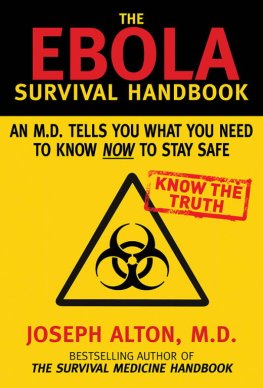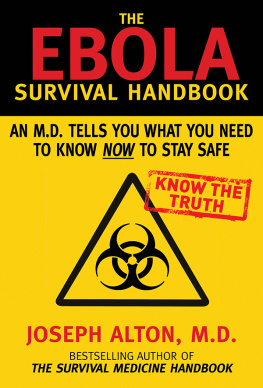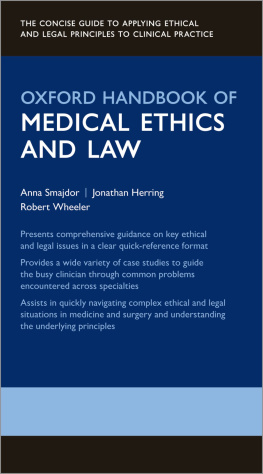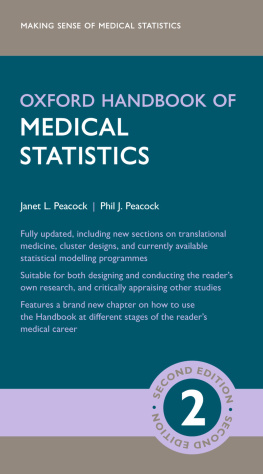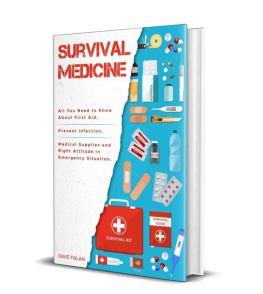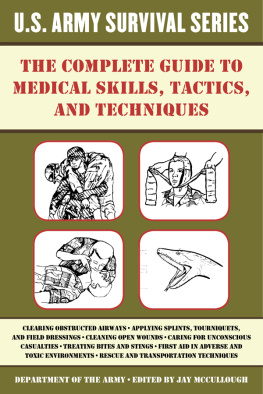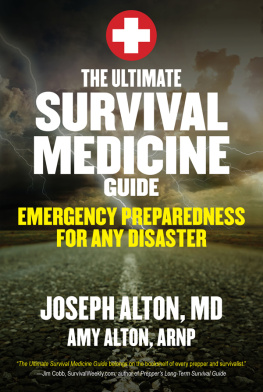

DISCLAIMER
The information given and opinions voiced in this volume are for educational and entertainment purposes only and does not constitute medical advice or the practice of medicine. No provider-patient relationship, explicit or implied, exists between the publisher, authors, and readers. This book does not substitute for such a relationship with a qualified provider. As many of the strategies discussed in this volume would be less effective than proven present-day medications and technology, the authors and publisher strongly urge their readers to seek modern and standard medical care with certified practitioners whenever and wherever it is available.
The reader should never delay seeking medical advice, disregard medical advice, or discontinue medical treatment because of information in this book or any resources cited in this book.
Although the authors have researched all sources to ensure accuracy and completeness, they assume no responsibility for errors, omissions, or other inconsistencies therein. Neither do the authors or publisher assume liability for any harm caused by the use or misuse of any methods, products, instructions or information in this book or any resources cited in this book.
No portion of this book may be reproduced by any electronic, mechanical or other means without the written permission of the authors. Any and all requests for such permission should be sent by email to .
Most illustrations by Jeff Meyer of anaseer.com
Copyright 2013 Doom and BloomTM, LLC
All rights reserved.
ISBN-13: 978-0988872530
ISBN: 0988872536

This book is dedicated to my wife Amy, whose positive attitude and sunny disposition truly puts the Bloom in Doom and Bloom. She is the person who first made it clear to me that this book was both possible to write and needed by those who want to be medically prepared in times of trouble.
JOSEPH ALTON, M.D.
I dedicate this book to my husband Joe, whose selfless attitude and compassion for his patients over the years has never wavered. He is unceasing in his efforts to help those who want to learn how to keep their loved ones healthy, in good times or bad.
AMY ALTON, A.R.N.P.
Additionally, we both dedicate this book to those who are willing to take responsibility for the health of their loved ones in times of trouble. We salute your courage in accepting this assignment; have no doubt, you will save lives.
JOSEPH ALTON, M.D. AND AMY ALTON, A.R.N.P.
DO WHAT YOU CAN, WITH WHAT YOU HAVE, WHERE YOU ARE.
THEODORE ROOSEVELT

Joseph Alton practiced as a board-certified Obstetrician and Pelvic Surgeon for more than 25 years before retiring to devote his efforts to preparing families medically for any scenario. He is a Fellow of the American College of Obstetrics and Gynecology and the American College of Surgeons, served as department chairman at local hospitals and as an adjunct professor at local university nursing schools. He is a contributor to well-known preparedness magazines and is frequently invited to speak at survival and preparedness conferences throughout the country on the subject of medical readiness. A member of MENSA, Dr. Alton collects medical books from the 19th century to gain insight on off-the-grid medical protocols.
Amy Alton is an Advanced Registered Nurse Practitioner and a Certified Nurse-Midwife. She has had years of experience working in large teaching institutions as well as smaller, family-oriented hospitals. Amy has extensive medicinal herb and vegetable gardens and works to include natural remedies into her strategies.
Dr. and Ms. Alton are devoted aqua culturists (currently raising tilapia) and aquaponic, raised bed, and container gardening experts. As Dr. Bones and Nurse Amy, they host a medical preparedness website at www.doomandbloom.net, and produce video and radio programs under the Doom and BloomTM label. Dr. and Ms. Alton are firm believers that, to remain healthy in hard times, we must use all the tools in the medical woodshed. Their goal is to promote integrated medicine; in this way, they can offer their readers the most options to keep their loved ones healthy in a long-term survival situation.


When we first embarked on the adventure of writing the first edition of this book, The Doom and BloomTM Survival Medicine Handbook, we were overwhelmed by the challenge that confronted us. Although there was a wealth of information about the occasional few of injury on a wilderness hike, books considered the possibility a setting so remote or devastated that NO hope of modern medical care existed for the long term. Even books that were meant for in third world environments often ended their use to get to modern medical chapters by exhorting their readers care as soon as possible.
We realized that we were in uncharted territory. Our concern was the major catastrophe that isolated a family from modern medicine for the long term. Trained personnel would not exist in this scenario, or would be overwhelmed by the demand for their services. What does a mother or father do in this circumstance? How would they deal with injuries or sickness? What could we, as medical professionals, do to improve their familys chances of surviving and staying healthy?
We decided that a how-to manual in plain English was the best option. We had to put together a strategy for each medical issue that we felt a head of household would encounter in times in trouble. It had to be simple. It had to make use of limited resources in a sustainable manner. It had to be realistic.
The last part was the hardest. Its difficult to make people believe that a head injury or a gunshot wound to the chest may not be survivable. No one wants to return to a time when, for example, pregnancy was a major cause of death. Its painful to think about, but we must face the hard truth, sometimes.
So we looked at every individual medical problem we could think of. How could we teach a non-medical person how to approach that problem in simple fashion? We considered what medical supplies they would need, how to use them, and how to replace them, when possible, with natural alternatives. More importantly, we figured out ways to best prevent medical problems.
It wasnt easy. Many times, we had to dig back into our collection of 19th century medical books to find methods that would be useful in grid-down situations. These methods werent superior to what modern medicine has to offer; as a matter of fact, some are downright obsolete. Despite this, we found a number of ways that our great grandparents used that might be of benefit in a long term survival setting.
When the book was published, we expected that, perhaps, a couple of hundred people might obtain it. A year later, tens of thousands have the book in their possession. The book has received acclaim and it has received criticism; luckily for us, more of the former than the latter.
Next page

